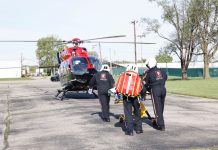If John Wall’s career at Cummins Inc. had a soundtrack, it would involve an orchestra.
As he prepares to retire from a company that sent him around the world to foster collaboration among the company’s engineering leaders, he compares his work during the past three decades to that of a maestro.
“As chief technical officer, I can’t play all the instruments,” he said.
“My job is to make sure they are playing all together.”
[sc:text-divider text-divider-title=”Story continues below gallery” ]
Wall is leaving the Columbus-based company at the end of this month after leading Cummins’ efforts to develop critical emission-control technologies and integrating them into the company’s products around the world.
Wall admits he came to Cummins with a lot to learn.
After grad school at MIT, he went to work at Chevron and was working on the effect of fuel properties on emissions.
Arriving at Cummins in 1986, he said he learned quickly from engineers and other mentors at his new company — and credits those teachers for much of his success.
It was a time when the Environmental Protection Agency and other federal agencies were just starting to turn their attention to diesel engine emissions, Wall said. And it was a time when he learned emissions research and development was not just about coming up with some cool technology in the lab.
“You actually have to create a product around it, and people have to buy it,” he said.
When he arrived, Wall said, some powerful work at Cummins was centered around Alyn Lyn, one of the first scholars allowed to leave China after the Cultural Revolution. J. Irwin Miller found him in the United Kingdom and hired him to work for Cummins, Wall said.
“He was the first one to do real computer modeling — mathematical modeling of the diesel combustion process,” Wall said.
It was on that strong technical foundation that Cummins embarked on not just meeting federal emission regulations but working with regulators to determine the standards and exceed them.
Wall believes strongly in developing standards that are tough, clear and enforceable.
In 2014, he received the Haagen-Smit Clean Air Award from the California Air Resources board, given annually to people who have made outstanding lifetime contributions in the fields of clean air, climate change, technology and related policies.
Wall, however, refuses to take personal credit.
“There have been thousands of people engaged in this, and I’ve just been fortunate to work in the technology part of development and with the leadership,” he said.
Paul Miller, Cummins director of corporate research and technology, external partnerships, described Wall’s work as the “long haul” between leading all the technical work of the early research phases of emission technology to production.
“He’s just incredibly sharp — incredibly deep technically,” Miller said. “It’s very inspirational to work for someone with that capability.”
Miller credits Wall’s foresight in realizing where the company would need to be 15 years into the future and leading it there.
“He’s a born leader,” Miller said.
Wall also is being lauded by Cummins for his role of transforming the company’s technical function from an engineering staff based primarily in Columbus to a global engineering workforce with more than 6,000 employees.
To do that, he decided Columbus technical engineering leaders needed to go overseas and experience and learn the cultures of the organizations in India, China and South America; and he led those delegations over the years.
“I’ve invested a lot of time going around the world,” he said, smiling as he added, “not just dragging everyone to Columbus, Indiana.”
The idea of not just learning about the culture but immersing in it for a time is about learning to collaborate, he said.
“I’ve worked really hard at building a global team, where the engineering leaders work well together,” he said. “It’s not enough to be smart and clever and knowledgeable. You have to be collaborative.”
Many engineers have heard him say frequently that engineering is a social exercise, Wall said.
As such, engineers would step outside Cummins to meet the community members where the company was located and learn more about what Cummins could do to help.
At the same time he was leading global team-building trips, he was also developing a reputation as someone who had an ability to easily explain complex technical concepts and ideas, something he laughs about, saying, “The world is not that complicated once you understand it.”
On certain technical topics, Wall will stop and back up to give a much simpler explanation when warranted. But he said Cummins team members might be giving him too much credit in this area, as his role as chief technical officer requires him to work in a wide range of areas and learn new things every day.
“The thing I tell engineers: ‘Make it seem simple and strangely easy to understand, but not so simple that they can do it without you,’” he said.
The credit might be coming in his ability to combine the technical aspects of the technical officer job, which he has had since 2000, with the social aspect of it.
Jean Thompson, who retired two years ago as Wall’s assistant after working with him for about a decade, knows well about Wall’s efforts to connect with his co-workers, some who were not even in emissions technology.
Wall would send out a note to employees who had reached 20-, 25-, 30- or even 40-year work anniversaries, even if he didn’t know the person, to recognize their service. Sometimes the letters would be in stacks on his desk, but he would find time to pen a personal note.
At his going-away party Oct. 2 at the Cummins Technical Center, one of those connections made years earlier returned to wish him well and to thank him.
Anchalika Pathak was in the junior class of young women attending engineering school in Pune, India, when she met Wall at the graduation ceremony for the seniors, and he took a moment to greet her and wish her well.
She graduated from the school and went on to Purdue University and now works for Cummins as an engineer in emissions research and development.
But she still has that photo of meeting Wall in India all those years ago and shared it with him at the farewell party.
“Cummins Emissions is the best — no one can beat us,” she said. “And that’s because of Dr. Wall.”
[sc:pullout-title pullout-title=”About John Wall” ][sc:pullout-text-begin]
Name: John C. Wall
Title: Vice president–chief technical officer, Cummins, Inc.
Age: 64
Education: Massachusetts Institute of Technology, 1971-1978; Georgia Institute of Technology, 1969-1971; undergraduate studies in mechanical engineering, transferred to MIT.
Employment:
Cummins Inc. Vice president–chief technical officer, March 2000-Oct. 31, 2015
Vice president–research & development, 1995-2000
Vice president–advanced engineering and technology planning, 1992-1995
Vice president–advanced heavy-duty engine development, 1991-1992
Executive director–advanced product development, 1989-1991
Director–1994 heavy-duty engines, 1988-1989
Director–emissions research, 1987-1988
Chief engineer–heavy-duty projects, 1986-1987
Joined Cummins Inc. in 1986
[sc:pullout-text-end]




